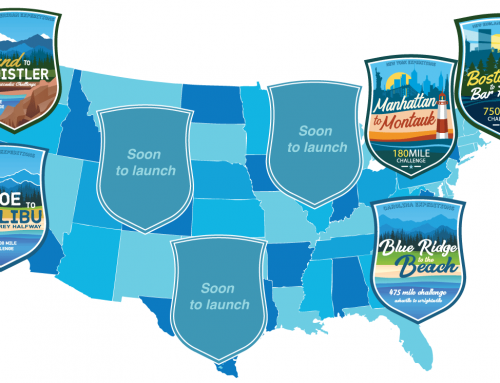By Brian Diaz
So you’ve made it this far. You decided 2014 was going to be your year to get back in shape and bought a gym membership, started going to some classes, maybe even hired a personal trainer. You feel much more fit than you have in a long time and you’re ready to kick it up a notch.
At this stage, you can go many different directions. You could be the gym rat who prefers to lift weights only and hang in the dumbbell room. You could be the class-goer who loves to socialize with others experiencing the same struggles that you have in getting fit. And you could be the person who wants to put an event on the calendar. Perhaps some of you have already done this and are now looking to make the next event even better. Be it a mud run, obstacle course challenge or 5k, let’s create some structure in your workouts.
For most people, time is the greatest limiter in getting in all they want to do in a given week. When I take a look at my week coming up and evaluate where and when I can get the workouts in, I make sure that I allow for recovery. Most people don’t need more than three days a week of running in order to make progress and reach their goals. Running requires a significant amount of energy (regardless of how efficient you are) and if you don’t allow the body to recover, you will get injured.
A group out of Furman University did extensive studies on their runners and came up with a good balance of running and cross-training to maximize gains. They published many of their results in the book “Run Less Run Faster,” and their findings form the basis of most of my prescribed running plans and programs. As a physical therapist, I’m always looking to keep athletes injury-free. With runners, chronic overuse injuries such as plantar fasciitis, Achilles tendonitis and IT band syndrome show up regularly in my clinic because their plan is not adequately designed. Volume and intensity are the only parameters that most plans seem to moderate. Recovery and cross-training are almost as important. The body, particularly the lower extremities and core, needs to be challenge in different ways and allowed to recover after that if injury is to be avoided.
Adding simple things like biking and indoor cycling, swimming or rowing, in addition to a quick 30-minute resistance set, is critical to unloading the same muscles used repetitively in running while getting stronger at the same time. I hate to generalize that one plan is best for everybody, and this may not work for you, but I have come up with an eight-week plan to help get you moving at your fastest. Try it and give me feedback; if you are looking to hit specific times, feel free to email me or consult with the book to see their suggested values for the track workouts. This eight-week modified plan should fit most runners who can at least run a 5k with no problems. Every Thursday and Sunday is designed as an off day where you can add yoga or a foam-roller session. On Tuesdays and Saturdays you add the cross-training component but never to exceed 60 minutes for now. One of my favorite routines is 40 minutes of indoor cycling with 20 minutes of TRX or resistance training.
8 Weeks To A Faster 5K
Week 1
Mon: 10-minute easy warmup, 400m, 600m, 800m (400m recovery interval RI), 10-minute cooldown
Wed: 1 mile easy, 1.5 miles push (exertion level 8-9/10), 1 mile easy
Fri: 4 miles tempo (exertion level 6-7/10)
Week 2
Mon: 10-minute easy warmup, 5x400m (400m recovery interval RI), 10-minute cooldown
Wed: 1 mile easy, 1.5 miles push (exertion level 8-9/10), 1 mile easy
Fri: 4 miles tempo (exertion level 6-7/10)
Week 3
Mon: 10-minute easy warmup, 400m, 2x800m (400m recovery interval RI), 10-minute cooldown
Wed: 1 mile easy, 1.5 miles push (exertion level 8-9/10), 1 mile easy
Fri: 4.5 miles tempo (exertion level 6-7/10)
Week 4
Mon: 10-minute easy warmup, 2x1000m (400m recovery interval RI), 10-minute cooldown
Wed: 1 mile easy, 2 miles push (exertion level 8-9/10), 1 mile easy
Fri: 4.5 miles tempo (exertion level 6-7/10)
Week 5
Mon: 10-minute easy warmup, 6x400m (400m recovery interval RI), 10-minute cooldown
Wed: 1 mile easy, 2 miles push (exertion level 8-9/10), 1 mile easy
Fri: 5 miles tempo (exertion level 6-7/10)
Week 6
Mon: 10-minute easy warmup, 3x800m (400m recovery interval RI), 10-minute cooldown
Wed: 1 mile easy, 2 miles push (exertion level 8-9/10), 1 mile easy
Fri: 5 miles tempo (exertion level 6-7/10)
Week 7
Mon: 10-minute easy warmup, 200m, 400m, 600m, 800m (400m recovery interval RI), 10-minute cooldown
Wed: 1 mile easy, 2 miles push (exertion level 8-9/10), 1 mile easy
Fri: 5 miles tempo (exertion level 6-7/10)
Week 8
Mon: 10-minute easy warmup, 4x400m (400m recovery interval RI), 10-minute cooldown
Wed: 2 miles easy, 10-minute walk
Fri: 1 mile easy, 5-minute walk
Sat/Sun: Race
# # #
Brian Diaz is the head physical therapist and sports specialist at ActivEdge Fitness & Sports Performance. He is a Level II Certified TRX Suspension Trainer and a USA Triathlon Certified Coach. Follow him on Twitter (@JediTriathlete) or go to his website at ExperienceTheEdge.com for more exercise ideas.






